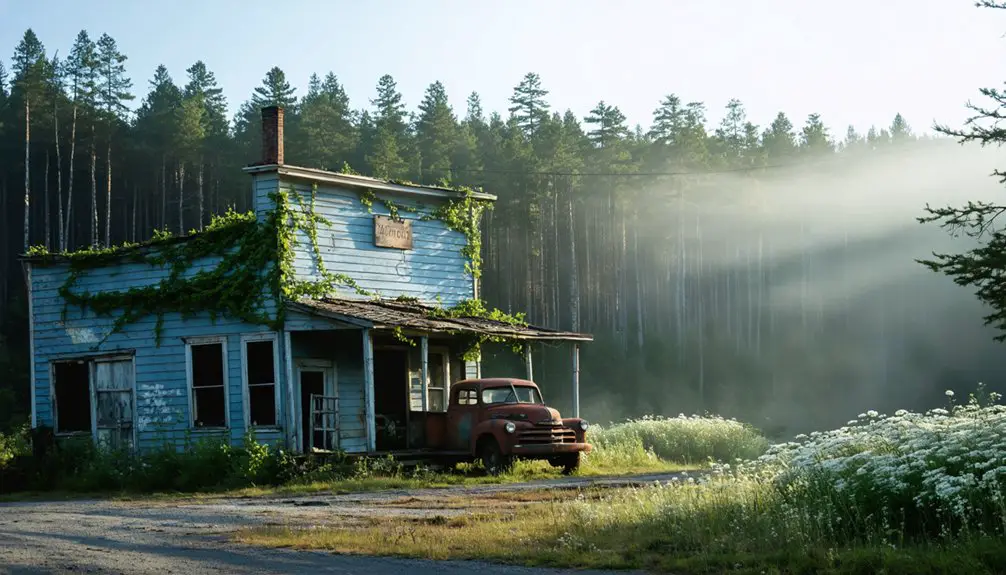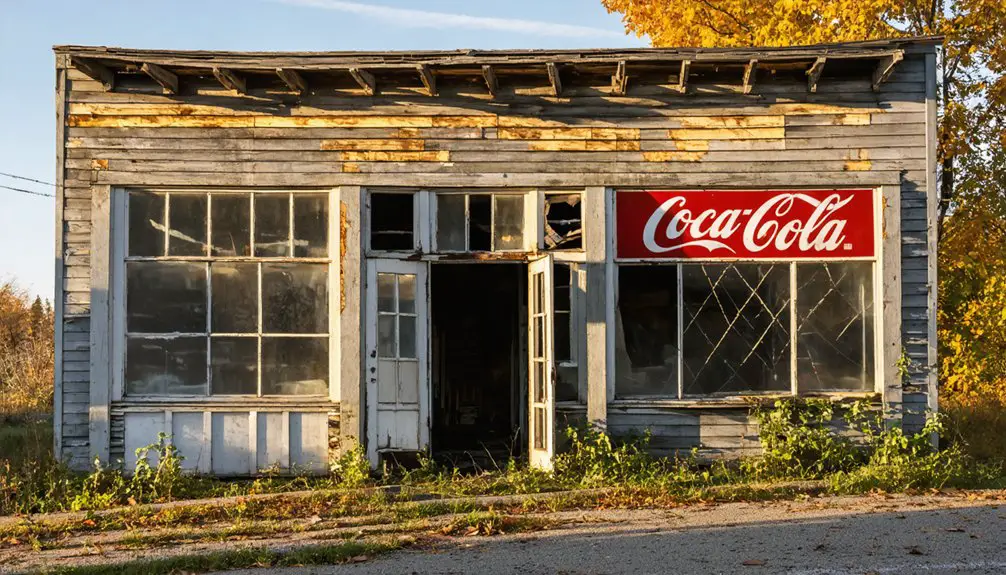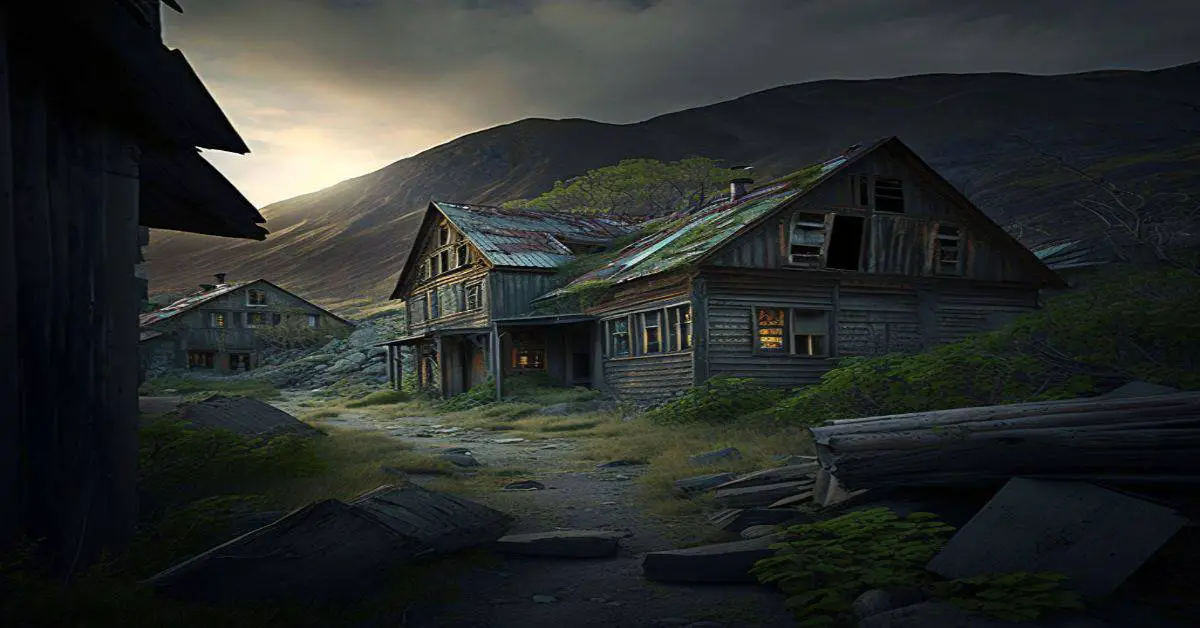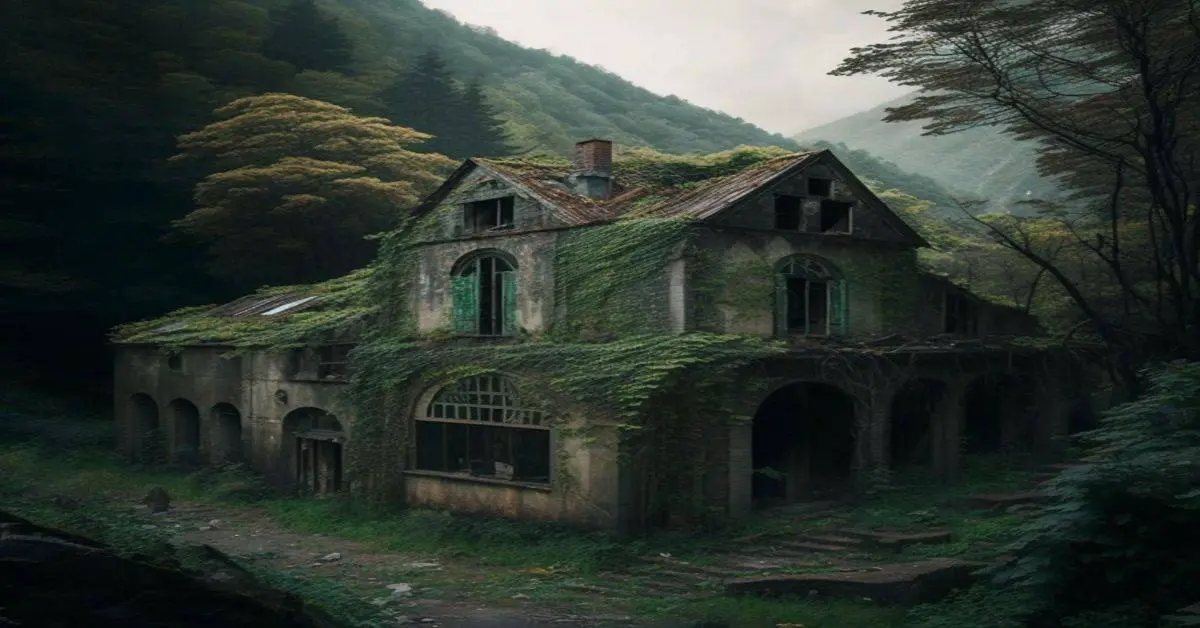You’ll find Mabel’s haunting ruins in Michigan’s Upper Peninsula, where a once-bustling copper mining town now lies abandoned. The site features scattered building foundations, an iconic smokestack, and remnants of its industrial past from the late 1800s. Local legends tell of a witch’s curse that brought disease and fires, while paranormal investigators report ghostly orbs and voices near the cemetery. The town’s mysterious decline and reported supernatural activity make it an intriguing destination for those seeking Michigan’s hidden history.
Key Takeaways
- Mabel was a 19th-century copper mining settlement in Michigan’s Upper Peninsula that declined in the early 20th century.
- The ghost town features scattered building foundations, an iconic smokestack, and remnants of primitive water systems and industrial equipment.
- Paranormal activity includes reported ghostly orbs, disembodied voices at the cemetery, and a legendary witch’s curse.
- Best explored during late fall through early spring when reduced foliage offers better visibility of historical structures.
- Historical preservation efforts are maintained through the University of Michigan’s Bentley Historical Library and local Heritage Days events.
The Rise and Fall of Mabel Mining Operations
While Indigenous peoples had mined copper in Michigan’s Upper Peninsula for millennia, Mabel’s mining operations emerged during the region’s 19th-century industrial boom.
Similar to Ravenswood’s evolution from alluvial gold mining to more complex extraction methods, Mabel’s success relied heavily on advancing mining technologies, including the installation of a 30-stamp mill and innovative Wilfley tables that improved ore concentration.
Located three miles east of Williamsburg in Grand Traverse County, the mining settlement benefited from its strategic position near rail transportation.
The operation’s economic sustainability peaked with the addition of modern extraction methods like cyanide treatment and Krupp ball mills around 1904.
These innovations, combined with efficient rail transport via the Chicago & West Michigan line, helped Mabel capitalize on surging copper demand during industrialization.
However, by the early 20th century, you’d see the operation’s decline as ore quality diminished and processing costs rose, making it increasingly difficult to maintain profitable extraction.
Life in a Copper Mining Settlement
Three distinct facets characterized daily life in Mabel’s copper mining settlement: grueling physical labor, diverse ethnic communities, and company-controlled infrastructure.
Your day would’ve started before dawn, climbing down nearly 1,000-foot ladders into dark, dusty shafts where you’d work in three-person teams. You’d drill and blast through rock while battling hazardous conditions and constant exposure to black powder fumes. Miners relied on primitive oil wick lamps to navigate the darkness underground. This demanding work produced an incredible 11 billion pounds of copper throughout Michigan’s mining history.
At home, you’d find yourself living among immigrants from across Europe, each group maintaining their cultural traditions through ethnic clubs and social gatherings.
The company’s grip on daily life was inescapable – they owned your house, ran the stores where you shopped, and controlled the community’s facilities. This created economic dependency while simultaneously fostering a resilient multicultural community that shaped Mabel’s identity.
Architecture and Infrastructure Remnants
You’ll find Mabel’s architectural legacy primarily in its scattered building foundations, where stone and brick bases outline the footprints of former homes, shops, and industrial structures along overgrown roadbeds.
The remnants of wooden buildings, now mostly collapsed, showcase the town’s reliance on timber construction, with rusted nails and deteriorated planks marking where walls once stood. Like many structures in Michigan’s ghost towns, these buildings have succumbed to the harsh winter conditions.
Bell towers and chimney fragments hint at the settlement’s mixed-use buildings, while traces of primitive water systems and industrial equipment bases reveal the careful planning that went into this once-thriving mining community. Standing above the town’s ruins, a solitary historical smokestack recalls the industrial heritage that once defined communities like Port Crescent.
Surviving Wooden Building Types
The diverse wooden structures of Mabel, Michigan reveal distinct architectural patterns common to 19th-century ghost towns across the northern region.
You’ll find evidence of log cabin architecture in the remaining residential buildings, with hand-hewn timbers and simple rectangular footprints that showcase early settler construction techniques. The settlement’s wooden church structures exhibit the characteristic one-room design with symmetrical windows and weathered clapboard siding. Some houses appear actively maintained as hunting camps, with old coolers and gas cans suggesting seasonal use.
Throughout the ghost town, you’ll discover remnants of commercial buildings featuring wide plank siding and board-and-batten exteriors.
Industrial structures, built with heavy timber framing, stand as proof of the town’s economic activity. These buildings used locally sourced materials and varied craftsmanship, adapting to the harsh northern Michigan climate while serving both practical and community needs. The region’s extreme weather conditions are evident in the building designs, as structures needed to withstand annual snowfall exceeding 300 inches in this part of Michigan.
Mine Shaft Support Systems
Beyond the wooden structures visible above ground, Mabel’s extensive mine shaft network represents a complex feat of engineering beneath the surface.
The shafts required sophisticated support systems to maintain stability against water pressure and geological challenges. You’ll find evidence of cable reinforcement techniques, where long grouted cables were pre-installed to provide tensioned support as mining progressed.
The mines utilized specialized backfill materials that balanced mechanical strength with proper drainage. These materials, combined with cementitious shotcrete and weldmesh reinforcements, prevented collapse while managing water infiltration. The installation of concrete pile systems helped stabilize the surface infrastructure and support heavy headgear loads.
The engineering team installed thorough water management systems, including dewatering equipment and monitoring sensors, to track stability and water levels. These innovations helped protect both the critical mining infrastructure and the workers who depended on these underground passages for their livelihood.
Town Planning and Layout
While exploring Mabel’s ruins today, you’ll discover a carefully planned company town that once divided into two distinct zones: a bustling mill complex and a railroad district connected by a principal thoroughfare.
The town design reflected efficient industrial planning, with structures clustered by function to maximize productivity and maintain social order. The sawmill possessed high-tech German machinery and represented the most modern industrial facility of its time.
You’ll find evidence of this organization through:
- Worker housing areas containing roughly 300 family cottages
- Communal facilities including a Swedish Lutheran church and two-room schoolhouse
- Industrial zones marked by concrete footings and wooden trestle remains
The layout strategically positioned the railroad facilities in the northern sector, complete with a roundhouse and depot, while the southern portion housed the mill complex with its associated worker dwellings and company store.
Local Legends and Supernatural Tales

Among Michigan’s most enigmatic ghost towns, Mabel harbors a rich tapestry of supernatural tales centered around a notorious witch’s curse. According to local witchcraft folklore, a woman, banished from the town, cast a vengeful curse that brought waves of disease and devastating fires, ultimately leading to the town’s abandonment.
You’ll find the most intense paranormal sightings at Mabel’s cemetery, where visitors report ghostly orbs, disembodied voices, and inexplicable handprints on vehicles.
The supernatural activity is often attributed to an alleged Native American burial ground beneath the town, though historians dispute this claim. The area’s haunted reputation draws paranormal investigators who document mysterious deaths, apparitions, and unexplained phenomena, making Mabel a focal point for those seeking to unravel its spectral mysteries.
Planning Your Visit to Mabel’s Ruins
When you’re planning a trip to Mabel’s ruins, you’ll need sturdy hiking boots and weather-appropriate gear to safely navigate the remote, marshy terrain and scattered remnants of the old settlement.
The best time to explore is during late fall through early spring when reduced foliage improves visibility of foundations, artifacts, and potential hazards like rusty metal or unstable wooden structures.
You should pack essential safety items including a GPS device, detailed maps, first-aid supplies, and plenty of water, while ensuring someone knows your planned route given the site’s limited cell coverage and distance from emergency services.
Safety and Access Tips
Before venturing to explore Mabel’s historic ruins, you’ll need to carefully plan your visit due to the site’s remote location in Michigan’s Upper Peninsula. The navigational challenges include unpaved forest roads and minimal signage, making GPS coordinates essential.
Wildlife awareness is important as you’ll encounter various animals and insects throughout the densely wooded area.
For a safe exploration, follow these vital preparations:
- Bring appropriate gear: waterproof boots, layered clothing, and a reliable GPS device with offline maps
- Pack safety essentials: first aid kit with tetanus supplies, emergency signaling devices, and ample water
- Navigate carefully: stick to established paths, watch for unstable foundations, and avoid marshy areas after rainfall
Remember to document your visit with photos rather than removing artifacts, preserving the site’s historical integrity for future explorers.
Best Viewing Seasons
Timing your visit to Mabel’s ruins requires careful consideration of Michigan’s distinct seasonal patterns.
Summer offers ideal exploration conditions with warm, stable weather and extended daylight hours, though you’ll encounter peak visitor traffic.
Fall presents prime seasonal photography opportunities, particularly from mid-September to mid-October when vibrant foliage frames the deteriorating structures.
Winter transforms the ruins into a stark monochromatic landscape perfect for atmospheric shots and stargazing, but you’ll need specialized gear for access.
Spring brings fewer visitors and emerging wildflowers, though muddy conditions can limit site access.
For the most rewarding visitor experiences, target early fall when moderate crowds, comfortable temperatures, and stunning colors combine to showcase Mabel’s remnants in their most photogenic state.
Essential Exploration Equipment
Proper preparation and equipment can mean the difference between a rewarding exploration of Mabel’s ruins and a problematic adventure. Your exploration gear should include durable hiking boots, protective gloves, and weather-appropriate clothing to handle Michigan’s unpredictable conditions and rough terrain.
Essential navigation tools and safety equipment for exploring Mabel’s remains include:
- GPS device with offline maps, printed topographic maps, and a reliable compass
- High-visibility vest, first aid kit, and insect repellent for tick and mosquito protection
- Headlamp with extra batteries, multi-gas detector, and dust mask for investigating structures
Remember you’ll likely encounter limited cell reception, so don’t rely on your phone.
Pack a lightweight tarp for emergency shelter, and always carry water and basic tools for clearing minor obstacles.
Historical Preservation Efforts
While physical remnants of Mabel have largely succumbed to decay, preservation efforts focus heavily on archival documentation, with the University of Michigan’s Bentley Historical Library housing the invaluable Mabel Edwards Secord collection.
You’ll find detailed documentary preservation materials including sawmill record books from 1901-1907, personal diaries, and correspondence that tell the story of daily life in this vanished community.
Local organizations complement archival research through annual Heritage Days and walking tours, keeping the town’s memory alive.
Unlike more extensively restored ghost towns such as Fayette, Mabel’s remaining structures maintain their authentic, weathered appearance.
This natural state, though challenging to preserve due to harsh elements and remote location, provides you with a genuine glimpse into Michigan’s industrial past.
The Legacy of Michigan’s Mining Heritage
The rise and fall of Michigan’s mining industry shaped the state’s economic landscape far beyond small communities like Mabel. The state’s iron ore and copper mining legacy represents an era of unprecedented growth, with Michigan leading the nation in iron ore production and reaching peak copper output of 266 million pounds by 1916.
You’ll find the impact of this industrial heritage reflected in:
- Mining techniques that evolved from small operations to massive open-pit mines, dramatically increasing production
- Economic prosperity that generated over $16.8 million from iron ore alone in 1898
- Social development through company towns, stores, and infrastructure that supported thousands of mining families
When mines closed during the Great Depression and post-WWII era, many communities couldn’t survive, leaving behind environmental challenges and ghost towns as evidence of Michigan’s mining heritage.
Frequently Asked Questions
Are There Any Surviving Descendants of Mabel’s Original Residents Still Living Nearby?
While you’ll find some local oral traditions suggesting family lineage connections, there’s no documented evidence of original residents’ descendants living nearby – just scattered possibilities throughout the surrounding region.
What Indigenous Tribes Inhabited the Mabel Area Before Mining Operations Began?
Before 15,000 Native Americans lived across Michigan, you’d find the Saginaw Chippewa Tribe’s three bands – Saginaw, Black River, and Swan Creek – maintaining their cultural heritage through hunting and river-based trade.
How Dangerous Is It to Explore Mabel’s Ruins During Winter?
You’ll face severe winter hazards including structural collapse, hidden mine shafts, and extreme cold. Without cell service and far from help, exploration safety depends on proper gear and traveling with others.
Were Any Significant Minerals Besides Copper Found in Mabel’s Mines?
You’d think they’d hit the mother lode of everything shiny, but nope! While miners used various mining techniques, they mainly found copper, with just minor silver deposits and trace minerals tagging along.
Did Mabel Have Its Own Newspaper or Other Documented Forms of Media?
You won’t find any local publications specific to Mabel in historical archives. Records suggest the town relied on regional newspapers from surrounding counties rather than having its own media outlets.
References
- https://www.visitkeweenaw.com/blog/post/our-top-7-keweenaw-ghost-towns-to-explore/
- https://promotemichigan.com/read-up-on-michigans-haunted-sites
- https://www.visitkeweenaw.com/things-to-do/museums-history/ghost-towns/
- https://www.youtube.com/watch?v=PNsiAFMsOpk
- https://michpics.wordpress.com/category/ghost-town/
- https://en.wikipedia.org/wiki/Ravenswood_Mining_Landscape_and_Chinese_Settlement_Area
- https://npshistory.com/publications/kewe/hrs.pdf
- https://www.nps.gov/kewe/learn/historyculture/copper-mining-timeline.htm
- https://www.michiganrailroads.com/stations-locations/92-grand-traverse-county-28/3225-mabel-mi
- https://ancestors.familysearch.org/en/96Y7-LNZ/mabel-martin-1882-1945


